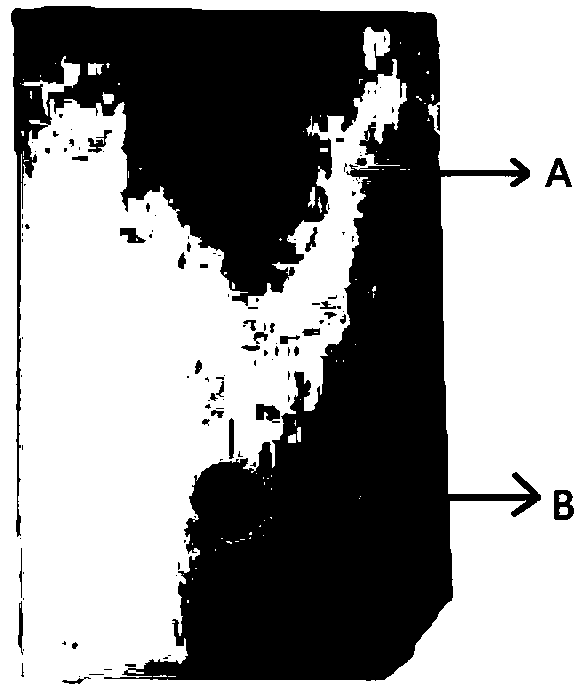Preparation and application of monoclonal antibody resisting m6A
A monoclonal antibody and carrier protein technology, applied in the field of medical bioengineering, can solve the problems of unclear transcript distribution and specific biological functions, limited m6A research, etc., and achieve high specificity and high affinity.
- Summary
- Abstract
- Description
- Claims
- Application Information
AI Technical Summary
Problems solved by technology
Method used
Image
Examples
Embodiment 1
[0038] Preparation of embodiment 1.m6A coupling complex:
[0039] The invention couples the antigen m6A to the keyhole limpet hemocyanin KLH, uses the conjugate as an immunogen, and enhances the immunogenicity of the small molecule m6A. The present invention uses commercial coupling kit (ReadiLink TM KLH Conjugation kit, AAT ) for coupling, the specific steps are as follows:
[0040] 1. Prepare KLH-m6A connection
[0041] 1) Use 200ul of ddH 2 O to dissolve KLH (vortexing and heating contraindicated).
[0042] 2) Weigh 2mg of m6A and dissolve it with 450ul of conjugation buffer.
[0043] 3) Mix 200ul of KLH solution and 450ul of m6A to form a KLH-m6A mixture.
[0044] 4) Use 1ml of ddH 2 O dissolve EDC, take 50ul and add KLH-m6A mixture, mix quickly and gently, and then incubate at room temperature for 2h.
[0045] 2. Purify KLH-m6A by desalting ion
[0046] 1) Use 10ml of ddH 2 O to dilute the Purification Buffer Salts.
[0047] 2) Twist the base of the desalting...
Embodiment 2
[0052]Example 2. Preparation and purification of monoclonal antibodies against m6A
[0053] 1. Preparation of Antigen Mixture
[0054] Take 25ul of the m6A coupling complex, add 25ul of normal saline to form 50ul of antigen dilution, and quickly mix with 50ul of adjuvant, that is, 100ul of antigen mixture (this is the immunization dosage of each BABL / C mouse ).
[0055] 2. Immunization of Animals
[0056] The immunized animals used in the present invention are BALB / c mice, and the immune adjuvant is KX0210041, purchased from Beijing Boaolong Immunotechnology Co., Ltd.
[0057] 1) Immune BABL / C mice by intramuscular injection of legs (100ul / only).
[0058] 2) Repeat immunization every other month for three times.
[0059] 3. Preparation and purification of monoclonal antibodies
[0060] Three healthy female BALB / c mice aged 8-12 weeks were immunized with the successfully obtained antigen mixture. The spleens of three mice were mixed and fused by rapid immunization of mice...
Embodiment 3
[0068] Example 3. Identification and detection application of anti-m6A monoclonal antibody
[0069] 1. Application of dot blot detection of monoclonal antibody:
[0070] Spot the m6A nucleoside solution and KLH protein solution on the nitrocellulose membrane respectively, wait for the solution to dry up, add blocking solution and block at room temperature for at least 1 hour; wash the membrane 5 times with PBST washing solution, and use the prepared monoclonal antibody as a Antibody, incubated overnight at 4°C. After the incubation, the membrane was washed 5 times with PBST washing solution, the HRP-labeled anti-mouse secondary antibody was diluted with antibody diluent, incubated for 1 h, and the membrane was washed 5 times with PBST washing solution. The enhanced HRP-DAB substrate chromogenic kit was used for color development, and the results were as follows figure 1 shown.
[0071] The results showed that the monoclonal antibody could more specifically recognize m6A, bu...
PUM
 Login to View More
Login to View More Abstract
Description
Claims
Application Information
 Login to View More
Login to View More - R&D
- Intellectual Property
- Life Sciences
- Materials
- Tech Scout
- Unparalleled Data Quality
- Higher Quality Content
- 60% Fewer Hallucinations
Browse by: Latest US Patents, China's latest patents, Technical Efficacy Thesaurus, Application Domain, Technology Topic, Popular Technical Reports.
© 2025 PatSnap. All rights reserved.Legal|Privacy policy|Modern Slavery Act Transparency Statement|Sitemap|About US| Contact US: help@patsnap.com



